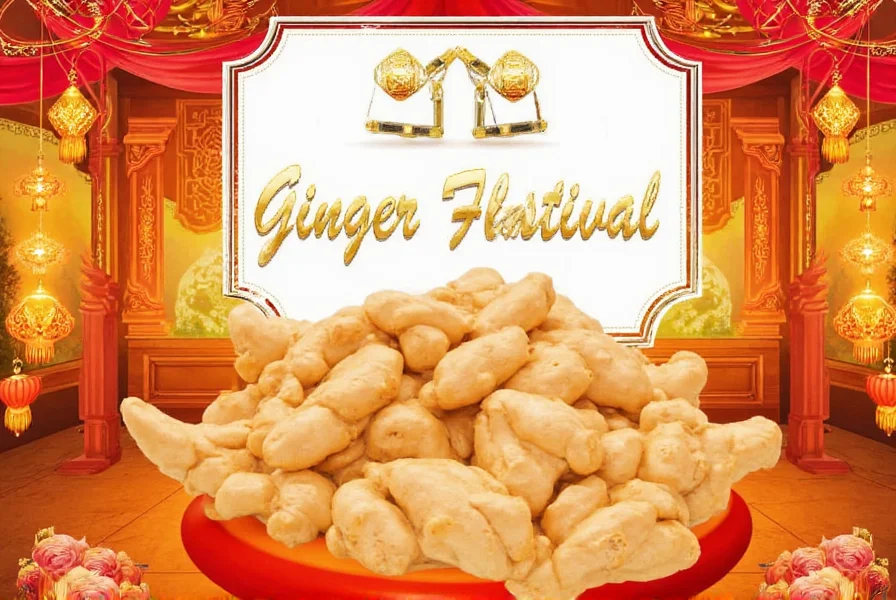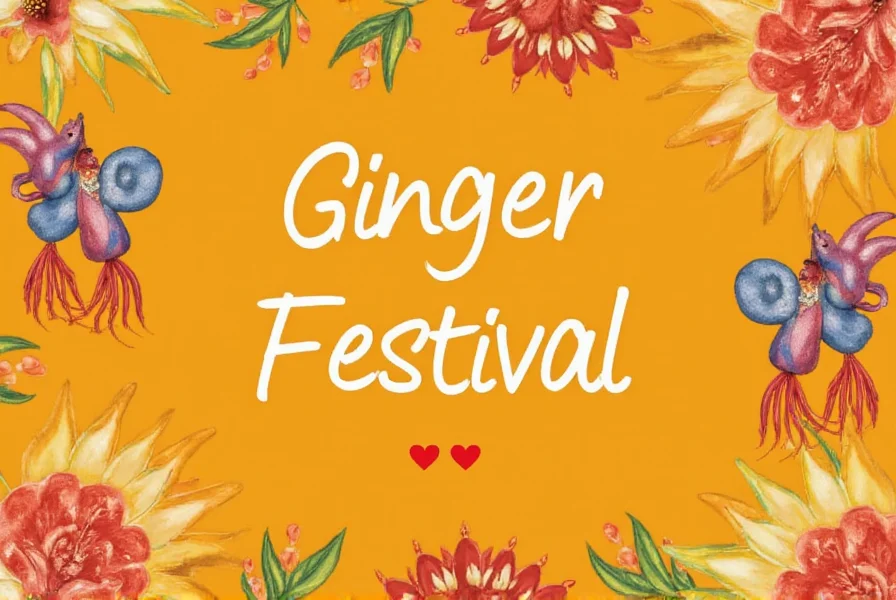Ginger festivals celebrate one of the world's most versatile and ancient spices, bringing together farmers, chefs, health enthusiasts, and cultural historians. These events highlight ginger's journey from ancient medicinal root to modern culinary staple, with the Hana community on Maui's remote eastern shore hosting the most famous celebration each spring.
The Origins of Ginger Festivals
Ginger festivals trace their roots to regions where ginger cultivation has been integral to local economies and traditions for centuries. In Hawaii, particularly in Hana, Maui, ginger farming became prominent in the late 20th century as farmers sought alternative crops after the decline of traditional sugar plantations. The unique microclimate of Hana proved ideal for growing premium ginger varieties, leading to the establishment of the first official Ginger Festival in the early 1990s.
Unlike commercial agricultural events, authentic ginger festivals maintain a community-focused atmosphere. They typically feature local growers sharing their expertise about different ginger varieties including yellow ginger, red ginger, and the prized white Hawaiian ginger. These celebrations preserve traditional knowledge while introducing innovative uses for this versatile rhizome.
Major Ginger Festivals Around the World
While numerous regions produce ginger, only a few host dedicated festivals celebrating this valuable crop. The following represent the most significant events for ginger enthusiasts:
| Festival Name | Location | Typical Dates | Special Features |
|---|---|---|---|
| Hana Gold Ginger Festival | Hana, Maui, Hawaii | April (varies annually) | Farm tours, cooking demos, artisan vendors, live Hawaiian music |
| Jamaica Ginger Festival | St. Elizabeth Parish, Jamaica | February-March | Ginger beer competitions, traditional jerk cooking, cultural performances |
| Coorg Ginger Festival | Kodagu District, Karnataka, India | December-January | Traditional harvest rituals, Ayurvedic workshops, local craft markets |
What to Experience at a Ginger Festival
Attending a ginger festival offers a multisensory experience that goes beyond simply purchasing ginger products. Visitors can expect:
- Farm tours - Guided visits to working ginger farms where you'll learn about sustainable cultivation practices specific to different ginger varieties
- Culinary demonstrations - Chefs showcase innovative recipes featuring fresh ginger in both traditional and contemporary dishes
- Artisan markets - Vendors selling ginger-infused products including teas, candies, skincare items, and handmade crafts
- Educational workshops - Sessions covering ginger's medicinal properties, historical significance, and proper storage techniques
- Cultural performances - Traditional music and dance reflecting the agricultural heritage of ginger-growing regions

Ginger's Cultural and Economic Importance
Ginger festivals serve an important purpose beyond celebration—they highlight ginger's role in sustainable agriculture and local economies. In regions like Hana, ginger farming provides economic stability for small-scale farmers who might otherwise struggle with traditional crop markets. These events also educate visitors about the differences between commercial ginger production and artisanal, small-batch cultivation.
The festivals emphasize ginger's remarkable versatility. Beyond its well-known culinary applications, visitors learn about ginger's traditional medicinal uses for digestion, inflammation, and nausea relief. Many festivals feature collaborations with local healthcare practitioners who discuss evidence-based health benefits of ginger consumption.
Planning Your Visit to a Ginger Festival
If you're considering attending a ginger festival, particularly the renowned event in Hana, Maui, proper planning ensures the best experience:
- Check official dates - Festival dates vary annually based on harvest conditions and community schedules
- Book accommodations early - Hana is remote with limited lodging options that fill quickly during festival season
- Prepare for weather - Tropical climates mean potential rain; lightweight rain gear is recommended
- Bring cash - Many small vendors at these community events operate on a cash-only basis
- Respect local customs - These are community events first, tourist attractions second; follow local guidelines
For those unable to attend in person, many festivals now offer virtual components including live-streamed cooking demonstrations and online marketplaces for local ginger products. This expanded accessibility helps support small growers while sharing ginger knowledge with global audiences.
The Future of Ginger Celebrations
As interest in sustainable agriculture and traditional foodways grows, ginger festivals are evolving to address contemporary concerns. Many now incorporate educational components about climate-resilient farming practices, soil health, and biodiversity conservation. Some festivals have expanded to include other complementary crops grown in similar conditions, creating broader agricultural celebrations while maintaining ginger as the centerpiece.
These events continue to serve as vital connections between consumers and the origins of their food, preserving agricultural heritage while adapting to modern interests in health, sustainability, and authentic cultural experiences. The enduring popularity of ginger festivals demonstrates the lasting appeal of this remarkable plant and the communities that cultivate it.

When is the best time to attend the Hana Ginger Festival in Maui?
The Hana Gold Ginger Festival typically occurs each April, with exact dates varying annually based on harvest conditions. Most years it falls on a weekend in mid to late April. Festival organizers usually announce specific dates 3-4 months in advance, so checking the official Hana community website in January or February provides the most current information.
What types of ginger varieties are featured at ginger festivals?
Ginger festivals showcase multiple ginger varieties including yellow ginger (most common commercial type), red ginger (with pinkish skin and stronger flavor), white Hawaiian ginger (milder flavor preferred for culinary uses), and sometimes rare varieties like turmeric ginger. Farmers often explain the different growing conditions, flavor profiles, and best uses for each variety during farm tours and educational sessions.
Are ginger festivals suitable for children and families?
Yes, most ginger festivals welcome families and provide child-friendly activities. The Hana festival in Maui typically includes hands-on activities like ginger planting demonstrations, craft stations using natural materials, and family-oriented cultural performances. The outdoor setting with space to move around makes it comfortable for children, though parents should prepare for tropical weather conditions and limited shade in some areas.
What should I bring when attending a ginger festival in Hawaii?
When attending a ginger festival in Hawaii, particularly in Hana, Maui, bring lightweight rain gear (the region is rainy), comfortable walking shoes for farm tours, sunscreen, a reusable water bottle, cash for small vendors, and a cooler if you plan to purchase fresh ginger or other perishable products. Since cell service can be limited in remote Hana, download maps and festival information in advance.
How do ginger festivals support local communities?
Ginger festivals provide significant economic support to local communities by creating direct sales opportunities for small-scale farmers and artisans. In Hana, Maui, the festival has helped sustain ginger farming as a viable alternative to declining traditional agriculture. These events also preserve cultural knowledge about traditional farming methods and ginger uses while attracting tourism revenue to otherwise remote areas, supporting local businesses throughout the festival season.
Frequently Asked Questions
When is the best time to attend the Hana Ginger Festival in Maui?
The Hana Gold Ginger Festival typically occurs each April, with exact dates varying annually based on harvest conditions. Most years it falls on a weekend in mid to late April. Festival organizers usually announce specific dates 3-4 months in advance, so checking the official Hana community website in January or February provides the most current information.
What types of ginger varieties are featured at ginger festivals?
Ginger festivals showcase multiple ginger varieties including yellow ginger (most common commercial type), red ginger (with pinkish skin and stronger flavor), white Hawaiian ginger (milder flavor preferred for culinary uses), and sometimes rare varieties like turmeric ginger. Farmers often explain the different growing conditions, flavor profiles, and best uses for each variety during farm tours and educational sessions.
Are ginger festivals suitable for children and families?
Yes, most ginger festivals welcome families and provide child-friendly activities. The Hana festival in Maui typically includes hands-on activities like ginger planting demonstrations, craft stations using natural materials, and family-oriented cultural performances. The outdoor setting with space to move around makes it comfortable for children, though parents should prepare for tropical weather conditions and limited shade in some areas.
What should I bring when attending a ginger festival in Hawaii?
When attending a ginger festival in Hawaii, particularly in Hana, Maui, bring lightweight rain gear (the region is rainy), comfortable walking shoes for farm tours, sunscreen, a reusable water bottle, cash for small vendors, and a cooler if you plan to purchase fresh ginger or other perishable products. Since cell service can be limited in remote Hana, download maps and festival information in advance.
How do ginger festivals support local communities?
Ginger festivals provide significant economic support to local communities by creating direct sales opportunities for small-scale farmers and artisans. In Hana, Maui, the festival has helped sustain ginger farming as a viable alternative to declining traditional agriculture. These events also preserve cultural knowledge about traditional farming methods and ginger uses while attracting tourism revenue to otherwise remote areas, supporting local businesses throughout the festival season.










 浙公网安备
33010002000092号
浙公网安备
33010002000092号 浙B2-20120091-4
浙B2-20120091-4